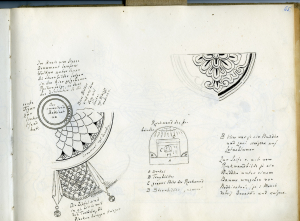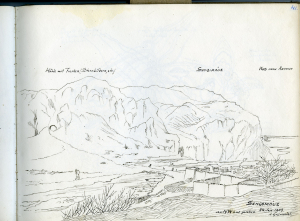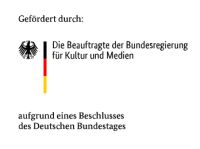The German Turfan Expeditions (1902-1914) in their files, photos and drawings
A cooperation project between the ‘Museum für Asiatische Kunst’ (AKu) the ‘Ethnologischen Museum’ (EM) and the ‘Staatsbibliothek zu Berlin’ | East Asia Department
At the end of the 19th and beginning of the 20th century, first Russia, then Germany, Great Britain, France and Japan undertook expeditions to Chinese Central Asia; among them were the important four German expeditions led between 1902 and 1914 by Albert Grünwedel (1856-1935) and Albert von Le Coq (1860-1930). The German expeditions were named after the main place of stay and excavation of the first expedition, Turfan (also Uyghur Turpan, Chinese Tulufan 吐鲁番), the largest oasis (approx. 170 square kilometres) on the old northern Silk Road. Turfan has become famous through the expeditions as an archaeological site that holds an unparalleled wealth of artefacts and texts in many languages and scripts. The expeditions were sent by the Königliche Museum für Völkerkunde in Berlin, initially privately financially supported by the great benefactor of the Berlin museums, James Simon (1851-1932), and – following his example – by the House of Krupp, the Prussian government, the museum itself and the “Ethnologische Hilfskomitee”, and since the second expedition from the “Allerhöchste Dispositionsfond” of Emperor Wilhelm II.
The first expedition left Berlin on the 11th of August 1902 and arrived in the Turfan oasis in November 1902. Fieldwork was initially carried out in Qocho, the old capital of the Uyghur Kingdom of the Oasis, but also in the neighbouring villages of Sengim, Bezeklik and Toyuq as well as in Qumtura near Kucha. The expedition returned to Berlin on the 6th of July 1903. Expedition members were Albert Grünwedel [leader], Georg Huth (1867-1906) and Theodor Bartus (1858-1941).
The second expedition left Berlin on the 12th of September 1904 and arrived in Turfan on the 17th of November 1904. The main areas of work were Qocho near Turfan and Bezeklik. Expedition members were Albert von Le Coq [leader] and Theodor Bartus (1858-1941). Both remained in the region and awaited the companions of the third expedition, Grünwedel and Hermann Pohrt, who left Berlin on the 16th of August 1905 to arrive in Kashgar on the 5th of December.
From there, they set out on the third expedition together. First to the ruin complex of Tumshuq, then to Kucha and on to the cave complexes of Qizil [Qïzïl] and Qumtura with magnificent wall paintings and other art objects, to the oases of Qarashahr and again Turfan and the nearby towns of Qocho, Murtuq and Bezeklik. The third expedition finally returned to Berlin in early June 1907.
The fourth expedition set out from Berlin on the 31st of March 1913 and reached Kashgar on the 16th of May 1913. The expedition, with members of Le Coq’s and Bartus’, worked on sites from Tumshuq to Kurla (near Qarashahr) and did not touch the Turfan oasis.
All early non-Chinese expeditions to Chinese Central Asia are accused of removing or taking away art objects and manuscripts, here especially many magnificent Buddhist, and to a lesser extent Manichaean and Christian wall paintings. The German expeditions, and especially the second and fourth led by Le Coq, had been particularly “successful” in taking wall paintings. Another serious point of criticism is the lack of documentation of the excavation activities, since – under constant mutual competition and thus considerable pressure to succeed – work was carried out at great speed.
The great merit of all expeditions to Chinese Central Asia, not only the German ones, is to have made available to international scholarship a wealth of scientific material that in many respects revolutionised Oriental, religious, linguistic and literary studies. Their textual findings have made three Middle Iranian languages known, documented linguistic stages of Persian, and richly attested Old Turkic as a pre-Islamic language. Two dialects of a previously unknown Indo-European language, “Tokharian A” (language of Qarashahr) and “Tokharian B” (Kuchaean), were discovered. The oldest Indian manuscripts of drama texts were found and the lost Manichaean religion was attested for the first time in its own writings.
The aim of this portal is to bring together the already digitised documents created in preparation for and in the course of the expeditions. In particular, the files, photos and drawings relating to the four Turfan expeditions, in order to offer them to scholars, researchers and the public. Thus creating simple access to the documents, enabling further important scientific work with the collections.
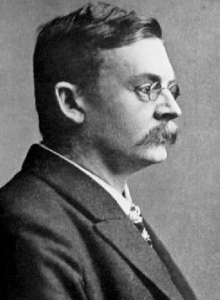
Albert Grünwedel (1856-1935) (Source: Wikimedia Commons)
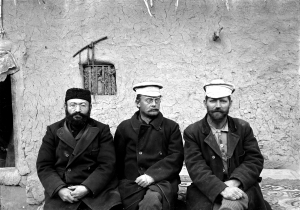
l.t.r. Georg Huth (1867-1906), Albert Grünwedel, Theodor Bartus (1858-1941) (© SMB | Aku, B 3054)
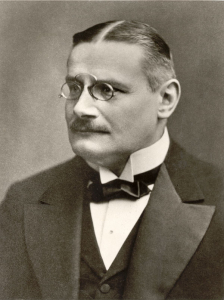
Albert von Le Coq (1860-1930) (Source: Wikimedia Commons)
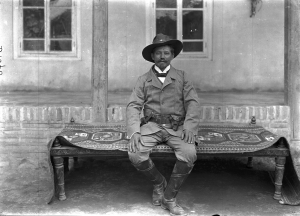
Theodor Bartus (© SMB | Aku B 1076)
Access to the files of the Turfan expeditions is nearing completion. You can already access the photos and drawings by clicking on the link below or in the respective collection segment.
Context of the Collection
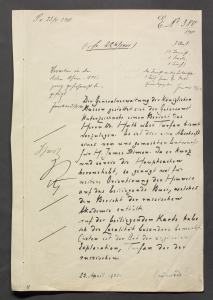
Letter by Albert Grünwedel ((© SMB | Aku, MV 1260_0066
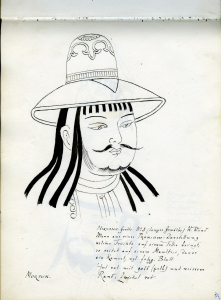
Albert Grünwedel, Drawing from Skizzenbuch Sängim ((© SMB | Aku, TA 6581, p. 15)
Preparation, planning and execution of the expeditions is comprehensively documented. The correspondence between the responsible persons of the institutions and authorities involved can be found in volumes of files, which are now kept in the Staatliche Museen zu Berlin, in the Geheime Staatsarchiv Preußischer Kulturbesitz (GStA) and to a small extent in the Bundesarchiv (BA).
The results of the four expeditions include the investigation of archaeological sites, drawn reproductions of wall paintings (mainly by Albert Grünwedel), the removal and taking away of art and archaeological objects (Buddhist statues and sculpture fragments, wall paintings, wall inscriptions, everyday objects, paintings on wood, silk and paper, textiles, coins, etc.) and of about 40,000 manuscript fragments, as well as the production of an extensive collection of photographs on glass plates. Grünwedel documented many archaeological sites and cave temples in detail; he was particularly interested in the graphic documentation of archaeological sites. The expeditions were also extensively photographed by the participants.
While the manuscript finds are now curated and restored in the Staatsbibliothek zu Berlin as a deposit of the Berlin-Brandenburgische Akademie der Wissenschaften (BBAW), the art objects, a smaller part of the manuscript finds (illuminated text finds), the photo collection and Grünwedel’s drawings are in the Museum für Asiatische Kunst (AKu). The ethnological collection (everyday objects and ceramics as well as sound recordings from the early 20th century) is stored in the Ethnologische Museum (EM).
The documents are accessible via interoperable IIIF image and metadata manifests (https://iiif.io/), thus allowing the objects to be freely integrated into other presentation environments. This also opens up the opportunity to optimise the description and presentation of the digital objects, to contextualise or to expand them to include further content that does not belong to the holdings of the Stiftung Preußischer Kulturbesitz.
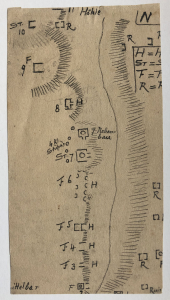
Albert Grünwedel, Sketch of a cave (© SMB | Aku, TA 6876_26)
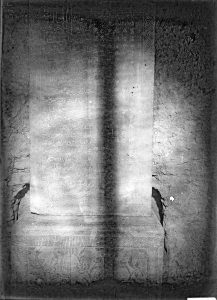
Photo of Inscription from Turfan (© SMB | Aku, B 1699)
Files
Three Berlin institutions preserve material on the German Turfan Expeditions. The material dates from 1899 to 1930 and documents the background for the sending as well as the preparation, planning, execution and accounting of the expeditions as well as the initiation of the fifth expedition to Chinese Central Asia, which was not carried out. Supplementary documents such as the correspondence with scientists accompanying the expeditions, as well as reports and applications with regard to the research, conservation and presentation of the objects brought back from Chinese Central Asia in what was then the Museum für Völkerkunde. There are 21 file volumes in the Museum of Asian Art (AKu). File volumes I to XV as well as file volume XVII contain the documents archived at the Museum für Völkerkunde (Königliche Museum für Völkerkunde, later Staatliche Museum für Völkerkunde). File volumes XVI and XVIII to XXI contain the correspondence that was originally kept at the so-called Turfan Committee (Lokalkomitee zur Erforschung Zentral-Asiens) and then, after the dissolution of the Committee, passed into the custody of the Museum für Völkerkunde. The five volumes of files kept in the Secret State Archives (GStA) contain the official correspondence concerning the second to fourth expeditions between the then Museum für Völkerkunde and the Ministry of Culture in the form of letters, applications, reports, queries, accounts and approvals. Two of the volumes exclusively contain invoices, receipts, vouchers, etc. According to current knowledge, at least one volume of files is stored in the Federal Archives (BA), which contains 39 relevant file items relating to the Turfan expeditions. These are essentially the correspondence between the Foreign Office in Berlin and the respective Imperial Envoy in Beijing, or between the latter and the Chinese Foreign Ministry. It usually concerns applications for Chinese passports for the expedition participants, but occasionally also other matters concerning the explorers.
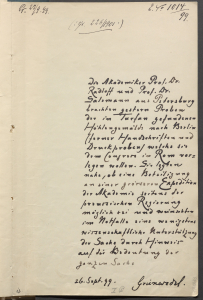
Letter by Albert Grünwedel (© SMB | Aku, MV 1260_40)
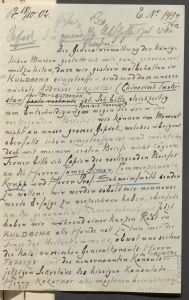
Letter about arrival in Kuldscha by Albert Grünwedel (© SMB | Aku, MV 1261_0078)
Photos
The expedition participants documented the expeditions in detail photographically. The only available support material at the time was glass plates coated with a gelatine-silver-bromide suspension, so-called gelatine dry plates. Today, more than 3,000 such glass plates are preserved in the Museum of Asian Art (AKu).
They show transient areas on the way to Chinese Central Asia, their inhabitants and landscapes, the expedition members at work, exterior and interior views of archaeological sites such as temples, cave paintings and other finds from the expeditions. They also contain their presentation in the former Museum für Völkerkunde in Stresemannstrasse in Berlin before the Second World War. The photos document archeological sites and places that are now lost, as well as numerous states of art objects that have not been preserved.
Naturally, these glass plates were damaged during transition. Considering the transport over thousands of kilometres on the expedition routes and back to Berlin, the frequent relocations in the museum building in Stresemannstraße, the war damage and post-war confusion, several relocations in Berlin and relocations within the museum building in Dahlem, it is nothing short of a miracle that a large number of plates have been preserved today despite these adverse circumstances.
Of many of them, however, there are only photo prints. These were already reproduced in the period shortly after the opening of the Museum für Indische Kunst (MIK) in 1972. If these were marked with the respective glass plate negative number, they were placed in the glass plate sequences. Nevertheless, there are numerous gaps in the holdings, which can hopefully be reduced in the future by matching them with the photo collection of the India Department of the AKu and that of the present Ethnological Museum (EM).
There are glass plate negatives and photo prints based on them in 4 formats:
Standard were the so-called B-plates of size 13 x 18 cm. Such high-resolution glass negatives were exposed until the 1920s. A travel camera of this format accompanied the four Turfan expeditions. 13 x 18 plates were also used for documenting museum pieces and for publication. Most of the important photographs date back to this format. There were once 2715 B plates in the Central Asia Collection, with important pieces from Gandhāra Province also in this B plate collection. In addition, numbers B 3000 – 3058 were re-inventoried at an unknown date. In the 1970s, plastic negatives were made from many B – glass plates and damaged glass negatives were discarded. They are easily recognisable as original B – photographs by their numbering. The occasional nitrocellulose negatives, which are easily combustible, can also be traced back to B-plates and have since been replaced by plastic negatives.
The A-plates are about half the size, namely 8 x 11 cm. These were used to produce photographs of objects, manuscripts, drawings and plans in the museum in the 1920s and 1930s. A majority of A-glass plates show copies of B-format prints as well as photographs from outside sources and publications. This format was apparently used – like photocopies today – mainly for the production of quick working photos and for the preparation of publications and exhibitions. The photographs were often not very carefully exposed. Nevertheless, the A glass plates are of great value today because they often reproduce otherwise unpreserved photographs and also document the work in the museum.
The C-plates are about twice as large as the B-plates, namely 18 x 24 cm. In this format, mainly outstanding individual pieces as well as interior photographs of the museum rooms were photographed. There are 185 numbers assigned to C-plates.
The glass positives are a special group. They are called Turfan slides or T-plates. There are still 692 of them in 9 x 12 cm format. Stored in 14 wooden boxes, they are all in good condition. They add to our knowledge of poorly or not preserved primary photographs on which they are based. Some of them are coloured.
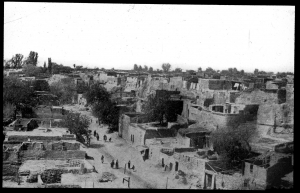
Street in Kashgar (© SMB | Aku, T 25)
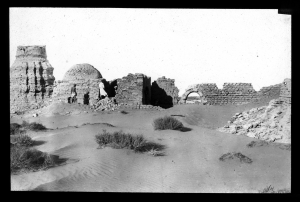
Hasar Shari (© SMB | Aku, T 16)
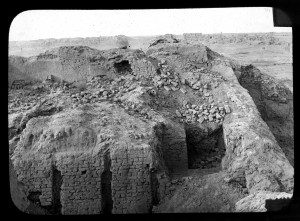
Temple (© SMB | Aku, T 153)
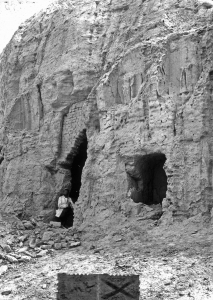
Grünwedel drawing (© SMB | Aku, T 2)
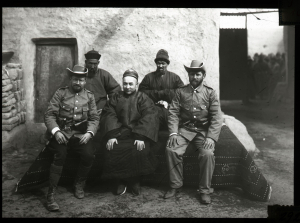
Front l.t.r Le Coq, der Wang von Luktschun, Bartus (© SMB | Aku, T 10)
Drawings
Since the 1990s, the drawings found scattered in the Turfan files and other collections were gathered in a separate collection of drawings. All drawings received TA (=Turfan Archive) numbers. They begin with TA 6430.
First and foremost, “drawings” refers to original works by Albert Grünwedel, but also originals subsequently processed by a paid museum draughtsman and redrawings of photographs as well as the resulting press proofs for publications. There are 490 such items in the collection. Judging by the number of drawings published in Grünwedel’s works, there must once have been many times this number of proofs for which there is no evidence of their whereabouts. Also lost are hundreds of sketches of plans and notes by Theodor Bartus, just as no diary has survived from any of the expedition members.
Little work has been done on the collection of drawings. The identification of the subjects and their places of publication has advanced, but discrepancies between the drawings and the proofs must be left to later editors. The history of individual “drawings” and their inclusion in the museum archive has also not yet been definitively researched.
Dabbs, Jack A., History of the discovery and exploration of Chinese Turkestan, The Hague: Mouton & Co.: 1963 (Central asiatic studies, 8) Dreyer, Caren, Bemerkungen zu den ‚Turfan-Akten‘, in IAZ (11) 2007, S. 33-42 idem, Abenteuer Seidenstraße. Die Berliner Turfan-Expeditionen 1902-1914, Leipzig 2015 idem, Die Fotosammlung Zentralasien des Museums für Asiatische Kunst wächst, in IAZ (23) 2019, S. 35-44 Durkin-Meisterernst, Desmond (Hrsg.), Turfan revisited : the first century of research into the arts and cultures of the Silk Road. (= Monographien zur indischen Archäologie, Kunst und Philologie ; Bd. 17 ), Berlin : Reimer 2004 Grünwedel, Albert, Bericht über archäologische Arbeiten in Idikutschari und Umgebung im Winter 1902-1903, München: Verlag der K. B. Akademie der Wissenschaften 1905 idem, Altbuddhistische Kultstätten in Chinesisch-Turkistan. Bericht über archäologische Arbeiten von 1906 bis 1907 bei Kuca, Qarašahr und in der Oase Turfan, Berlin 1912 idem, Briefwechsel und Dokumente, Hartmut Walravens (ed.), Wiesbaden: Harrassowitz 2001 (Asien-und Afrika-Studien der Humboldt-Universität zu Berlin ; 9) Gumbrecht, Cordula, Acta Turfanica. Die Deutschen Turfan-Expeditionen gesehen in den Archiven von Urumchi und Berlin, Berlin, 2002 (https://repository.crossasia.org/receive/crossasia_mods_00000032) idem, Chinese Passports for the German Turfan Expeditions, in Turfan revisited, Berlin, 2004, S. 111-120 idem, Beyond all praising. A Letter of Thanks from the German Turfan Explorers, in: Dunhuang Studies: Prospects and Problems for the Coming Second Century of Research, hrsg. v. I.Popova und Liu Yi, Slavia Publishers, St. Petersburg, 2012 idem, Grünwedel’s sketch-book of Sängim, Turfan, in: The way of Buddha: the 100th anniversary of the Otani Mission and the 50th Härtel, Herbert u. Yaldiz, Marianne, Die Seidenstraße, p. 12. Cf. hier, S. 12 – 31, auch zur „Entdeckung und Erforschung Chinesisch-Zentralasiens“ bzw. zur „Geschichte der deutschen ‚Turfan‘-Expeditionen (1902-1914)“ Hopkirk, Peter, Foreign devils on the Silk Road, Oxford, 1980 (excellently written, but evidently without knowledge of the Berlin Acta of the Turfan expeditions.) Jacobs, Justin M. The Compensations of Plunder, The University of Chicago, 2020 Klementz, Dimitrij, Turfan und seine Altertümer, St. Petersburg: 1899 (Nachrichten über die von der Kaiserlichen Akademie der Wissenschaften zu St. Petersburg im Jahre 1898 ausgerüstete Expedition nach Turfan. Heft 1). Zaturpanskij, Choros (A. v. Le Coq), Reisewege und Ergebnisse der deutschen Turfan-Expeditionen, in: Orientalisches Archiv 3(1913)3:116-127 idem, Die vierte deutsche Turfan-Expedition, in: Túrán (1918)1/2: 7-24 idem, Auf Hellas Spuren in Ostturkistan. Berichte und Abenteuer der II. und III. Deutschen Turfan-Expedition, Leipzig: J.C. Hinrichs’sche Buchhandlung 1926 idem, Von Land und Leuten in Ostturkestan. Berichte und Abenteuer der 4. Deutschen Turfanexpedition, Leipzig: Hinrichs 1928 Sundermann, Werner, Turfan Expeditions, in: Encyclopaedia Iranica, Leiden, 2004
of the Research Society for Central Asian Cultures. Ed.by Irisawa Takashi, Kyoto: Ryukoku University, c2010. 269 p. illus. (Cultures of the Silk Road and modern science, vol. 1)
This portal shows the results of the project Non-textual Materials as Source and Research Subject: the Turfan Expeditions and the Berlin Collections, a project of the Staatsbibliothek zu Berlin in cooperation with the Museum für Asiatische Kunst and the Ethnologische Museum.
The project was funded by the Federal Government Commissioner for Culture and the Media (BKM).
More information on the project is available here.
